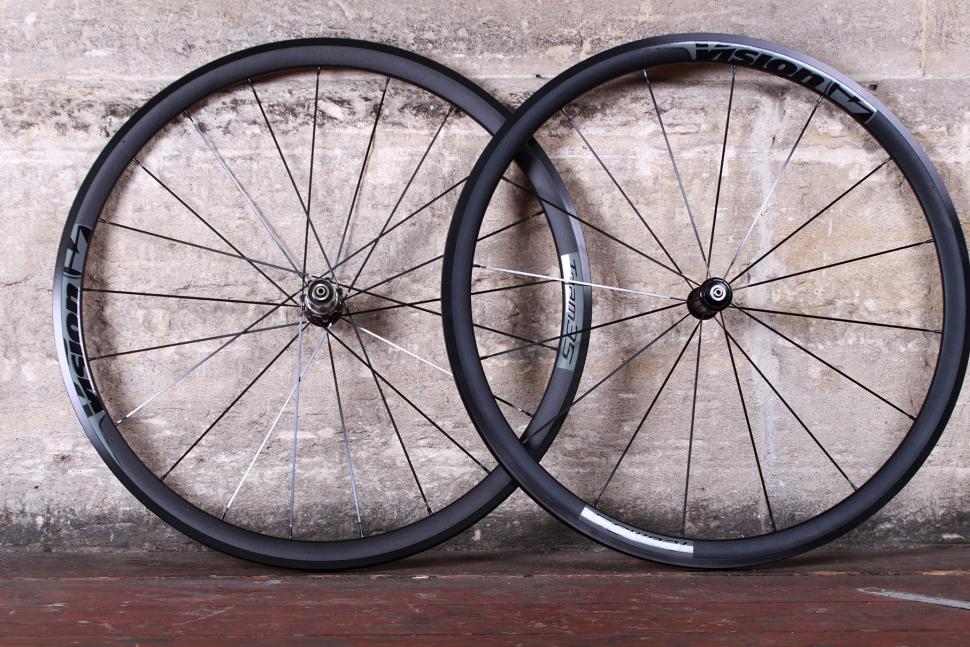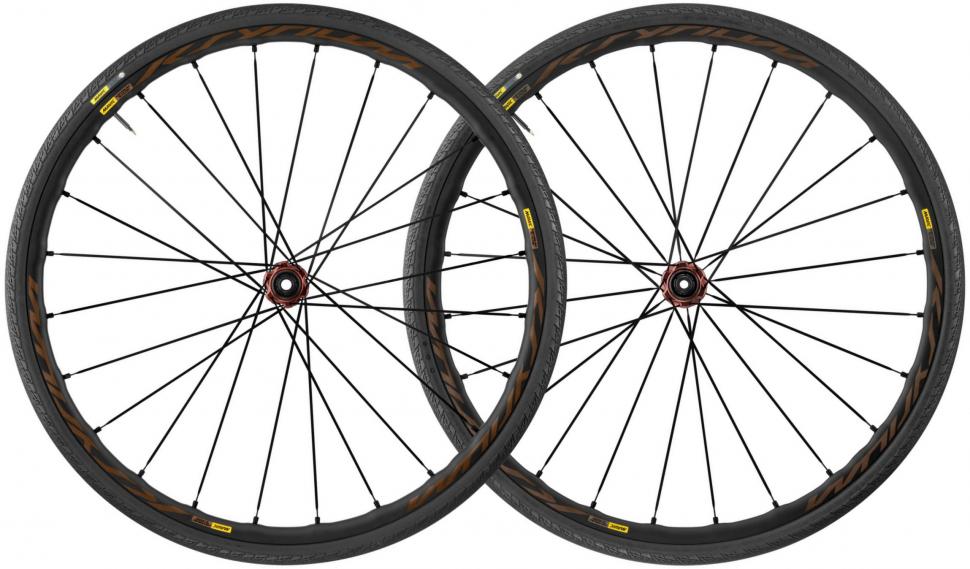One of the most popular upgrades, better wheels (and tyres) can dramatically improve your bike’s ride.
Stock wheels are often heavy and of mediocre quality — upgrading can reduce weight and improve reliability.
If you want to go faster, choose wheels with deep-section rims; aerodynamics is far more important than weight.
You’ve a choice of clinchers, tubulars or tubeless, with matching tyres; each system has pros and cons.
Wheels benefit from the human touch; the best handbuilt wheels are still superior to wheels built entirely by machine.
Upgrading the wheels is one of the first changes many people make to their bikes. Why are wheels so important and how do you choose a better set of hoops?
It's one of the bike industry's guilty secrets: the wheels on even quite pricy road bikes are often a bit ordinary. That means upgrading your wheels can make a big difference to the feel and performance of your bike.
There are several reasons why you might want better wheels. If you're doing a lot of commuting on bad roads (the potholed streets of just about any UK major city for example) you might want a set of beefy wheels for weekday riding, and to switch to something lighter or more aerodynamic for the weekend.
Or you might have decided to keep the run-of-the-mill wheels your bike came with for training and to fit better-performance wheels for sunny days and important events.
>> Read more: All wheel reviews on road.cc
Wheel construction
![]()
The basics of wheel construction haven't changed in decades because, quite simply, they work extraordinarily well. A bike wheel can carry hundreds of times its own weight; pretty remarkable structural efficiency.
Your basic tension-spoked wheel consists of a hub that houses bearings so the whole thing can turn easily, a rim for the tyre to sit on and steel spokes under tension that hold it all together.
The tension in the spokes is the vital factor. When you load a wheel, the tension goes down in the spokes between the hub and the ground. As long as it never hits zero, the wheel can support you and your bike.
![]()
Nevertheless, wheels have evolved in the last couple of decades, and now usually have fewer spokes and deeper rims, both changes that improve aerodynamics. The spokes themselves may be flattened to better cut through the air too.
Perhaps the biggest change is the use of carbon fiber for rims. That's made possible deep, highly aerodynamic rims with minimal weight penalty. Carbon wheels are still more expensive than wheels with aluminium rims, but prices have been steadily decreasing for the last few years.
Tubulars, clinchers and tubeless
![]()
In terms of how tyres mount, there are three types of wheel rim. Rims for tubular tyres — which have the inner tube sewn into the carcass — have a shallow dip where the tyre is glued on. These are the lightest rims, and tubular fans say their soft floaty ride is unparalleled. However, for the vast majority of people the faff of gluing, and the difficulty of fixing a punctured tubular makes them too much hassle.
![]()
Clincher or wire-on rims have raised sidewalls with a hook where the tyre bead engages, and the tyre has a separate inner tube. In other words, this is the standard bike rim and tyre we all know and love. Fixing a flat is a simple matter of changing the tube and swapping tyres just requires tyre levers and a pump.
Tubeless tyres are a special case of clinchers. Tyre and rim are manufactured to precise tolerances to enable an airtight seal. The rim has no holes and the tyre is coated internally with rubber so there's no need for an inner tube. Some manufacturers forego the rubber coating and base their tubeless systems around use of sealant. That has the advantage of making them more resistant to penetration punctures, in addition to their natural resistance to pinch punctures.
Weight vs Aerodynamics
![]()
If performance is your aim, there's strong evidence that you should put more priority on aerodynamics than weight. Way back in 2001 bike engineer Kraig Willett analysed the forces on wheels and concluded:
"When evaluating wheel performance, wheel aerodynamics are the most important, distantly followed by wheel mass. Wheel inertia effects in all cases are so small that they are arguably insignificant."
That goes against the long-standing conventional wisdom that wheel weight is vitally important to performance because wheels have to be spun up to speed as well as moved along the road.
But you don't do much accelerating when you ride a bike, and even when you do the speed changes involved are relatively slow. That means you spend most of your time, and therefore effort, simply shoving the air out of the way, and you should choose wheels accordingly.
Pro teams have drawn similar conclusions, which is why you now see far more deep-section wheels in the peloton than you did even ten years ago. Aero wheels are free speed in a breakaway or sprint.
The big disadvantage of deep-section wheels is the effect of crosswinds, which can blow you off track. Some wheels are less affected than others. Zipp's Firecrest shape is widely considered to be among the least problematic thanks to its bulged sidewalls.
Rim width
![]()
Just as tyres have become a bit wider in recent years, with the previously ubiquitous 23mm size giving away to 25, 26 and even 28mm tyres, so rims have spread out too. All other things being equal, a wider rim makes for a stiffer, stronger wheel and also makes the tyre effectively a bit fatter.
Wider rims are also claimed to be more aerodynamic because air flows more smoothly between tyre and rim if they are about the same size. Wheel maker Mavic has taken this to its logical conclusion with its CX01 Blades, plastic fairings that fill the groove between its Yksion CXR tyre and Cosmic CXR wheel. The UCI won't let pros use them, but that doesn't affect triathletes and UK time trial riders.
Can we build it?
![]()
Wheelbuilding (CC BY-NC-ND Cory Grunkemeyer:Flickr)
If you want your wheels to be durable, then how they were built is just as important as the components that went into them. For wheels to be durable, the tension needs to be high and even. If it's not high then spokes can come loose as you ride because the tension can drop to zero under load. If the tension is not even then the wheel is unlikely to stay round and true, even if it's that way out of the box.
A step in the wheel-building process called 'stress-relieving' also improves wheel longevity by preventing fatigue failure at the spoke heads. If your relatively new wheels start breaking spokes it's a good bet they weren't stress-relieved properly when they were built.
Most wheels these days are built by machines. It's possible to set up wheel building machines to get all of these things right, or very nearly right, but sometimes factories take short-cuts, especially when the objective is to build inexpensive wheels. The less time each wheel spends in the machine, the more wheels the factory can build.
![]()
Spokes (CC BY-NC-ND 2.0 Jon Bowen:Flickr)
That's why machine-built wheels have a poor reputation, but if a wheel builder doesn't know what he or she is doing, humans can build poor wheels too. The most efficient way of mass-producing high-quality wheels seems to be to let machines quickly do the spadework and then finish them by hand, as Joe Graney found when Santa Cruz decided to build its own wheels.
Alternatively, you can get top-quality wheels that have been built by hand from start to finish, either off-the-peg or custom built. Barnoldswick parts-meisters Hope have been making well-regarded wheels for years, including road wheels, while Hunt Bike Wheels is a new entrant in the field. You'll find wheels built by several others in the selection below.
If you want something truly special, a wheelbuilder who really knows their stuff can help you choose exactly the right combination of hubs, rims and spokes for your needs. The doyen of this approach in the UK is probably Liverpool's Pete Matthews whose resume includes building wheels for Tour de France King of the Mountains Robert Millar, legendary rouleur Sean Yates and comedian Alexei Sayle. Many good bike shops have a similar if less storied figure lurking in the workshop, quietly crafting wheels that last until the rim sidewalls wear out.
Names to look for
The major wheel brands nevertheless produce good wheels, by and large. Riders report thousands of happy miles on wheels by Mavic, Bontrager, Shimano, Reynolds, Zipp, DT Swiss and many others. Here are some of our favourite wheels from the last couple of years.
The Knight 65 Carbon Fibre clinchers offer very good stiffness, but their real skill is in cutting through the air at high speeds and feeling stable with it.
These wheels – Knight's own rims laced to DT Swiss 240 hubs – have a whole lot going for them. Okay, at 65mm deep they're never going to be particularly light, our pair coming in at 1,680g (including rim strips and skewers), but that's not unusual. For comparison, Zipp's 404s are a claimed 1,505g (you also need to factor in the weight of the rim strips and skewers) and Bontrager's 70mm-deep Aeolus 7s are a claimed 1,610g.
It's when you fire the Knight 65s up to speed that things get impressive. As tester Mat Brett put it: "I have a few routes that I ride regularly as personal time trials for reviewing bikes and kit – rolling rather than hilly – and I've used these wheels to help achieve consistently fast times over several weeks and in a wide variety of conditions. I measure power every ride and my view is that these wheels are offering impressive speeds for the wattage I'm putting out. It's unscientific and highly anecdotal, so take it or leave it, but this is my experience."
Read our review of the Knight Composites 65 DT Swiss 240 wheels
Find a Knight Composites dealer
![Prime Road Race alloy wheelset.jpg Prime Road Race alloy wheelset.jpg]()
Prime Road Race alloy wheelset.jpg
The Prime Race Road Alloy Clincher wheelset is a lightweight and hardwearing tubeless-ready choice for general road use and even gravel/cyclo-cross riding.
The Prime Race wheels put in an excellent performance out on the road, offering plenty of stiffness and durability, and braking is as firm and reliable as you'd expect on an aluminium surface. We used them for general road riding and also put them on a cyclo-cross bike and hit the local gravel roads and byways a few times. They've done a great job throughout.
They're light too. Ours weighed in at 662g (front) and 868g (rear) – a total of 1,530g (without skewers or valves). That's exactly the overall weight that Prime claims.
Read our review of the Prime Race Road Alloy Wheels
DT Swiss RRC 65 Dicut clinchers — £1,999.98
![DT Swiss RRC 65 Dicut C - 1.jpg DT Swiss RRC 65 Dicut C - 1.jpg]()
DT Swiss RRC 65 Dicut C - 1.jpg
They might be a lot of money but these DT Swiss RRC 65 Dicut clincher wheels are fast and stable, and they offer a good braking performance too.
These wheels are at their best when slicing along at high speed. They maintain pace beautifully with an appreciably lower resistance than shallow section rims. The RRC 65s also accelerate well, especially considering their 65mm rim depth. Weighing 745g (front) and 885g (rear) – excluding skewers; combined weight is 1,630g (DT's official total weight is 45g lower) – they spin up to speed with little fuss. For comparison, Zipp's 58mm deep 404 Firecrest Carbon Clinchers have claimed weights of 725g and 895g (1,620g total).
Some people might consider 65mm a little deep for general road use but we rode with these wheels on both a road bike and more occasionally on a TT bike for six weeks and they were superb. We really rate these wheels highly, and not just for racing against the clock.
Read our review of the DT Swiss RRC 65 Dicut clinchers
Find a DT Swiss dealer
![Vision Team 35 Wheelset .jpg Vision Team 35 Wheelset .jpg]()
Vision Team 35 Wheelset .jpg
Vision's Team 35s are competent and durable entry-level race wheels, with the added bonus of being very comfortable for a set of semi-deep-section alloy clinchers. The black anodised finish gives them a cool stealth look too.
The Team 35s are a revamped version of Vision's long-standing T35 model, and with a recommended retail price of £229.95 they sit right at that level of a first serious performance upgrade for a lot of bikes.
At first glance they seem a bit porky at 1,820g, especially considering the quoted weight is some 100g less than that, but the good thing is they never feel sluggish out on the road. You notice it a little if things get really steep or you ask for some rapid acceleration from a standing start, so if you're searching for a climber's set of wheels, look elsewhere.
Otherwise, the Team 35s are hard to knock. Considering the depth of the alloy rim, you'd expect them to feel harsh, but they don't.
Read our review of the Vision Team 35 wheels
Find a Vision dealer
![Swiss Side Hadron 625 wheelset.jpg Swiss Side Hadron 625 wheelset.jpg]()
Swiss Side Hadron 625 wheelset.jpg
"Hur hur hur your wheels are called Hard... oh no, wait, it's Hadron." To Swiss ears, the name may well conjure up the crowning peak of European scientific endeavour, but it's perilously close to something that provided regular amusement to the Sunday morning crew back at home. That's as may be, but the Swiss Side Hadron 625s are stonkingly good wheels, offering arguably the best performance in this price bracket on the market today.
They use a hybrid aluminium-carbon rim to give aluminium-rim brake performance and class-leading aerodynamic performance, at a price way below the big players like Zipp and Enve. And by god they sound good.
Read our review of the Swiss Side Hadron 625 wheels
![]()
The least expensive wheels we've ever given four and a half stars, the Superstar Pace 28s demonstrate that custom handbuilt wheels can be competitive on weight and reliability with any factory wheels. They have wide rims in the modern style and are built on reliable Icon hubs. They're comparable to substantially more expensive wheels from other manufacturers; light enough to race on while still managing to be as tough as old boots, and look how shiny they are.
Read our review of the Superstar Components Pave 28 wheels
![Hunt 4 Season Dura Road Wheelset.jpg Hunt 4 Season Dura Road Wheelset.jpg]()
Hunt 4 Season Dura Road Wheelset.jpg
Hunt's 4Season Dura Road wheels are an excellent all-round choice. These wheels are strong, not over-heavy, tubeless-ready and evenly built. As a first upgrade over heavy stock wheels, or as a good quality winter or all-round option, they're right on the money.
they feel tightly built, and a quick check with the spoke tension gauge revealed plenty of tension, evenly distributed.
They never feel ponderous, and we set a fair number of Strava PBs on them after we swapped the lighter wheels out. Okay, some of them might have been wind-assisted... we had to go out in the wind, you see, to check how they behave in blustery conditions. Very well is the answer, not surprisingly for a shallow box rim. They're unfazed by even dramatic sidewind gusts.
We had no issues with the 4-pawl freehub, nor with the sealed EZO bearings. Everything ran smoothly in spite of being subjected to some biblical conditions. The supplied skewers are an external cam, with a nylon insert instead of the brass one you get on the more expensive Hunt wheels, but they did the job without any fuss.
Read our review of the Hunt 4Season Dura Road
Find a Hunt dealer
![]()
The 1,540g weight of these wide, tubeless-ready wheels is impressive for an aluminium wheelset even if that is about 65g over the claimed weight. With the Bortolas Pro-Lite haven't sacrificed strength or durability to achieve it, it's more of a by-product of well chosen, proven components.
On the road, they're smooth and comfortable, but light enough to reward a little out of the saddle dig on a steep section while climbing.
Overall the Bortolas are perfect all rounder wheels that only really lose out in terms of aerodynamics due to that shallow rim.
Read our review of the Pro-Lite Bortola A21 wheels
![Pro-Lite Revo A21 Disc Clincher Wheelset.jpg Pro-Lite Revo A21 Disc Clincher Wheelset.jpg]()
Pro-Lite Revo A21 Disc Clincher Wheelset.jpg
Road disc and gravel wheels are getting better, lighter and cheaper, and right at the forefront of that trend are the Pro-Lite Revo A21s. At 1,650g, with a Centerlock option, thru-axle compatibility and a wide track rim, they're a bargain, and pretty future-proof too.
Pro-Lite builds all its wheels by hand and the Revos arrived nice and true, with even spoke tension. The spokes are bladed and triple butted, and Pro-Lite uses a brass washer at the spoke head to better distribute the forces there.
The Revos use a 21mm deep rim (hence the name), which is 23.8mm wide externally and 19mm internally. That makes it ideal for 28-32mm tyres, although 25mm rubber and bigger chamber tyres will be fine too.
Read our review of the Pro-Lite Revo A21W
Find a Pro-Lite dealer
![Stans NoTubes ZTR Grail Disc Wheelset Stans NoTubes ZTR Grail Disc Wheelset]()
Stans NoTubes ZTR Grail Disc Wheelset
We've been hugely impressed with these wheels. With 25mm slicks at high pressures they're fast on the road, and bombproof when riding with knobbly tyres at low pressures off-road. They're a decent weight, the hubs are easily interchangeable to different axle standards, and the company's Bead Socket Technology (BST) means getting a tubeless tyre inflated is a cinch.
The Grail rims are wide: 24mm on the outside, 21mm on the inside. The rims are also quite deep, 24.5mm, making them the company's deepest – and therefore more aero – rim to date. They're constructed from aluminium and weigh a claimed 460g apiece. The BST rim profile features a shallow seating area so the tyre bead locates right up against the side of the rim. Getting a Schwalbe One tubeless tyre to inflate was ridiculously easy – a slosh of sealant inside and a track pump to inflate the tyre.
If you want a disc- and tubeless-ready wheelset with a wide rim profile to make the most of the growing number of wide tubeless tyres, the Stan's NoTubes ZTR Grail Team wheels combine a competitive price, decent weight and impressive performance. Add in the easy tubeless compatibility and axle versatility, and they're seriously worth considering.
Read our review of the Stan's NoTubes ZTR Grail Team
Find a Stan's NoTubes dealer
![]()
The original factory wheels, Mavic Ksyriums have come a long way since their first appearance in 1996, and remain extremely popular upgrade wheels. In their latest incarnation they boast a claimed weight of 1550g and have slightly wider rims than before, following the current trend. Mavic claims the resulting fatter tyre shape is worth a 13% reduction in rolling resistance or you can drop the tyre pressure 20psi for a comfier ride at the same rolling resistance. Your £420 also gets you a pair of 25mm Mavic Yksion Pro tyres.
Find a Mavic dealer
![]()
Traditional looks meets modern width in these wheels from Swiss-based Edco, which have 22mm wide rims and are ready for Tubeless tyres like those offered by Hutchinson, Bontrager or Schwalbe.
There are a lot of clever touches to these wheels like the MultiSys freewheel body, designed to accept both Shimano/SRAM and Campagnolo cassettes so you don't need new wheels if you ever change gearing allegiance.
These wheels ride well, are a sensible 1571g and come with a whopping eight-year guarantee.
Read our review of the Edco Optima Roches (22mm) Tubeless Ready Wheels
Find an Edco dealer
![]()
With the Stiletto wheels, Spada's emphasis is on minimum weight, but not at the cost of strength or stiffness. Stilettos are surprisingly good all rounders — we tested them on a winter training bike on a variety of fairly rough roads and they didn't flinch — but we'd probably still reserve them for riding fast, smooth roads in decent weather.
Spada markets the Stilettos as its 'regular use' wheel option, and they're certainly tough enough We'd still put them part way between regular use and 'special rides only' simply because they'll suffer if you don't treat them well. Aluminium spoke nipples need keeping clean, an aluminium cassette body soon starts burring on the splined edges under regular duress and ceramic bearings aren't exactly cheap to replace.
Nevertheless these are lovely, light wheels that make a bike feel a bit more sprightly under acceleration, thanks to their low weight.
Read our review of the Spada Stiletto wheels
Find a Spada dealer
![Cosine 45mm Carbon Clincher wheelset.jpg Cosine 45mm Carbon Clincher wheelset.jpg]()
Cosine 45mm Carbon Clincher wheelset.jpg
Is an upgrade to carbon fibre wheels worth it? If these Cosine 45mm carbon clinchers are anything to go by then the answer is a resounding yes, and not just for performance – comfort also receives a boost.
At 1710g they aren't in the superlight category, but then again not many deep-section carbon wheels are because of the extra material. The acceleration of the Cosines is impressive and certainly belies what you'd expect from wheels of this weight.
Comfort is the biggest surprise, though. Going from a relatively shallow alloy rim to a mid-depth carbon one with the same tyres was like letting 20-30psi of pressure out. It's not because they lack stiffness either; under hard acceleration and climbing there is no flex at the rim at all.
The Cosine wheels are quick and certainly roll well over undulating terrain. You get the odd bit of buffering from crosswinds, which might affect you a bit if you're a light rider, but we've certainly ridden much, much worse.
Read our review of the Cosine 45mm Full Carbon Clinchers
![Swissside Hadron 485 wheelset Swissside Hadron 485 wheelset]()
Swissside Hadron 485 wheelset
Hadron wheels (named after that big circular tunnel near Geneva, of course) are available in rim depths of 48.5mm, 62.5mm and 80mm (front)/85mm (rear). All share the same fundamental construction, with aluminium rims and carbon fairings. Swiss Side says it's done an enormous amount of work to perfect the aerodynamic design of these rims, focusing on aerodynamic drag and also minimising the sensitivity to side-winds.
they've performed well in a wide variety of riding. We won't pretend that we can accurately determine the difference compared with other quality aero wheels of a similar depth, but they certainly feel like they're in the same ball-park, holding speed really well and making a rather satisfying hum in the process.
Read our review of the Swiss Side Hadron 485
Find a Swiss Side dealer
![Fulcrum Racing Quattro Carbon DB wheelset.jpg Fulcrum Racing Quattro Carbon DB wheelset.jpg]()
Fulcrum Racing Quattro Carbon DB wheelset.jpg
The Fulcrum Racing Quattro Carbon DB wheels could well redefine the modern bicycle wheel. They're bang on trend for a broad range of today's disc brake-equipped bikes and promise the trinity of light, fast and strong.
First, they're the right material: carbon fibre, with a 3k core and unidirectional surface. And while Fulcrum doesn't tout them as tubeless ready, they are, with only the valve hole in the bed of the 40mm-deep aero section rims.
The broad carbon rims are laced with 18 spokes in the front and 21 in the rear – a number low enough to keep the weight down, but high enough to make the wheels feel bombproof.
Paradoxically, they ride like function-specific race-day wheels, all revved up and raring to rip up the road, and so, naturally, you expect them to be fragile and delicate, with a need to be guarded from harm and children's sticky fingers. In reality, they're street tough and ready for couple of pints and a scrap.
Read our review of the Fulcrum Racing Quattro Carbon DB
Find a Fulcrum dealer
![]()
The shallowest of three rim options in Profile Design's Twenty Four carbon fibre wheel range offers very good performance for the money.
The wide rims make for extra cushion from whatever wheels you fit, and the shape provides good aerodynamics and stability; they would be ideal as an everyday wheelset or for UK sportives and road races.
Braking has been the Achilles' heel of carbon rims in the past, but with Profile's own brake blocks the braking performance is highly impressive with consistent and progressive stopping.
Read our review of the Profile Design 38/TwentyFour Clincher wheels
Find a Profile Design dealer
![]()
These wheels are now known as the Dark Energy DMX440 Fat Boys, but the differences from the wheels we reviewed are a matter of incremental changes that should make them even better. The rim's now slightly deeper at 40mm, the carbon layup has been tweaked and there are a few more spokes.
The XLR38s offered bags of speed with a fat rim profile reminiscent of a Zipp or Enve but at a fraction of the price. We expect the Fat Boys to be just as good, making them an ideal upgrade for anyone looking to invest in their first deep section carbon wheels.
Spin offers a choice of rim depths, laced to its own SPN Precision hubs. With the 40mm rims, they weigh 1465g per pair. That's a very competitive weight, certainly for the price. You won't get much lighter unless you're prepared to spend quite a lot more money. Braking with the supplied QuickStop Black Shadow brake blocks was excellent.
Read our review of the Spin K2 Carbone XLR38 25mm Fat Boy Clincher wheels
![]()
The ultimate in aero wheel performance comes with the combination of a deep rim, a wide tyre bed and a shape that's not affected badly by sidewinds. The Reynolds Aero 58s fit the bill.
On the road, the Aero 58s are discernibly fast and easily give you a 2km/h speed increase over a high profile wheel such as a Mavic Ksyrium. Reynolds claim best-in-class stability is sidewinds and out testing bore this out. Consistent, high cross winds proved no problem whatsoever, it was only in really gusty conditions, such as when passing a gap in a hedgerow, that the 58s could be unsettled.
Braking performance in the dry is very good, not so great in the wet, but no worse than most carbon rims, and while the 1601g weight isn't feathery, it's pretty good for such deep wheels.
Fast, quick-accelerating and superbly stable in crosswinds, the Aero 58s are our benchmark in carbon clincher performance.
Read our review of the Reynolds Aero 58 clincher wheels
Find a Reynolds dealer
![Lightweight Meilenstein wheelset Lightweight Meilenstein wheelset]()
Lightweight Meilenstein wheelset
Yes, they're very expensive, but the Lightweight Meilenstein carbon tubulars are superlight and equally stiff, resulting in an exceptional performance out on the road.
As the name suggests, Lightweight makes very light wheels. Our Meilensteins, with 47.5mm-deep and 20mm-wide rims, hit the road.cc Scales of Truth at 480g for the front (Lightweight claims 475g) and 640g rear (Lightweight claims 625g). That's a total of just 1,120g. The skewers add 44g.
You might expect that because they weigh so little the Meilensteins will flex about all over the place as soon as you jack up the power. That would seem logical, but the biggest surprise in their performance is that they're very, very stiff.
From the first pedal stroke you can feel that these are light wheels and acceleration is little short of superb. Really, you'll be astonished.
Read our review of the Lightweight Meilenstein tubular
Find a Lightweight dealer







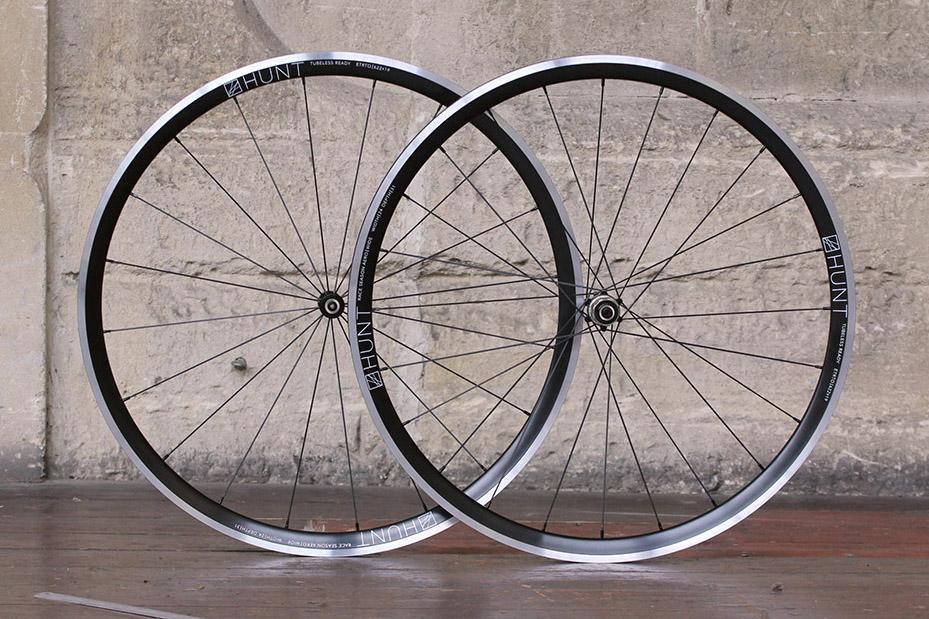

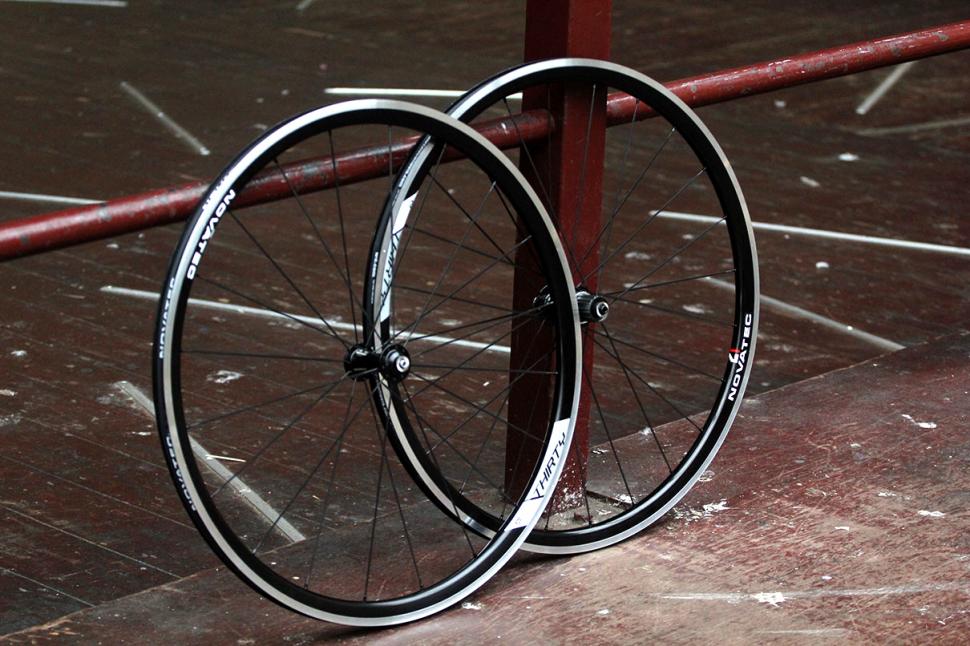
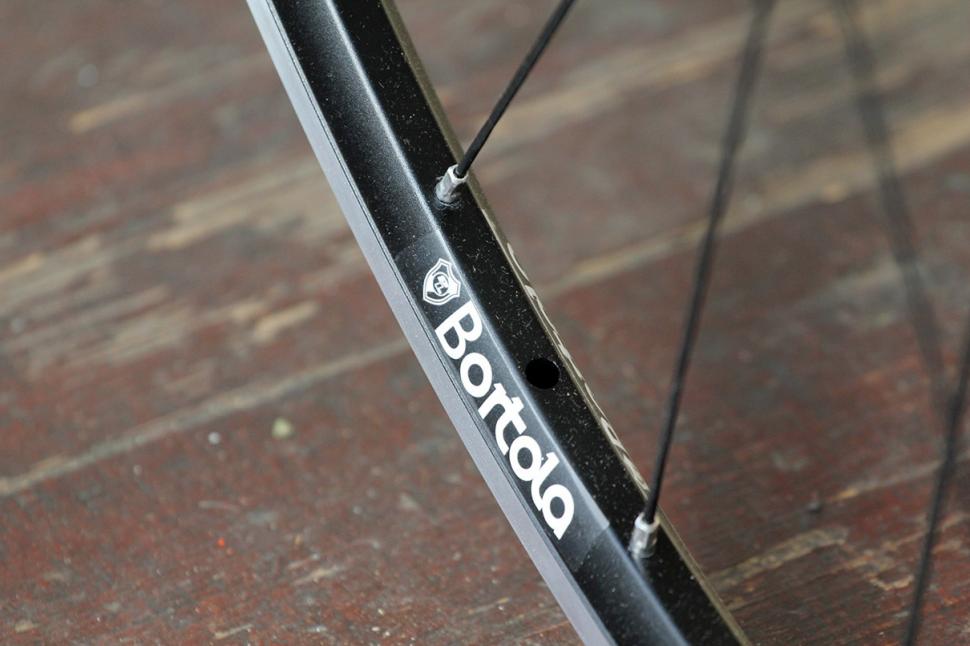








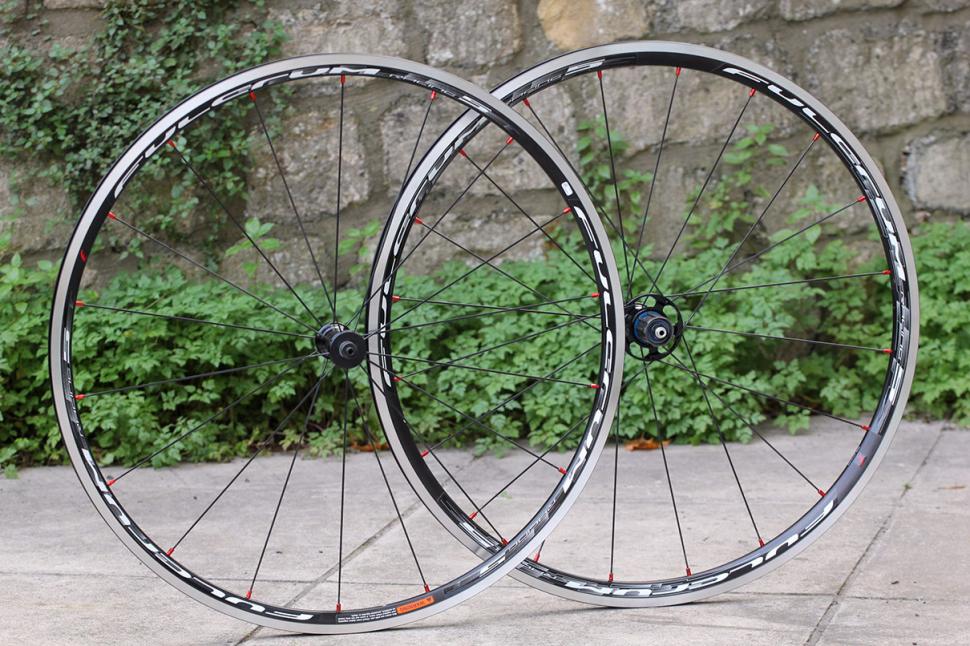

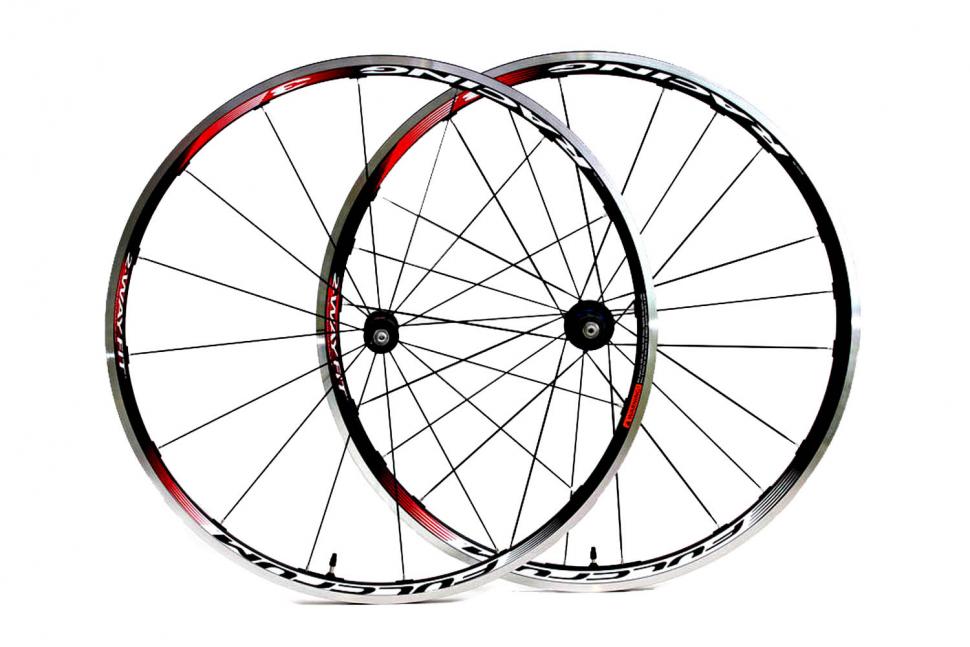

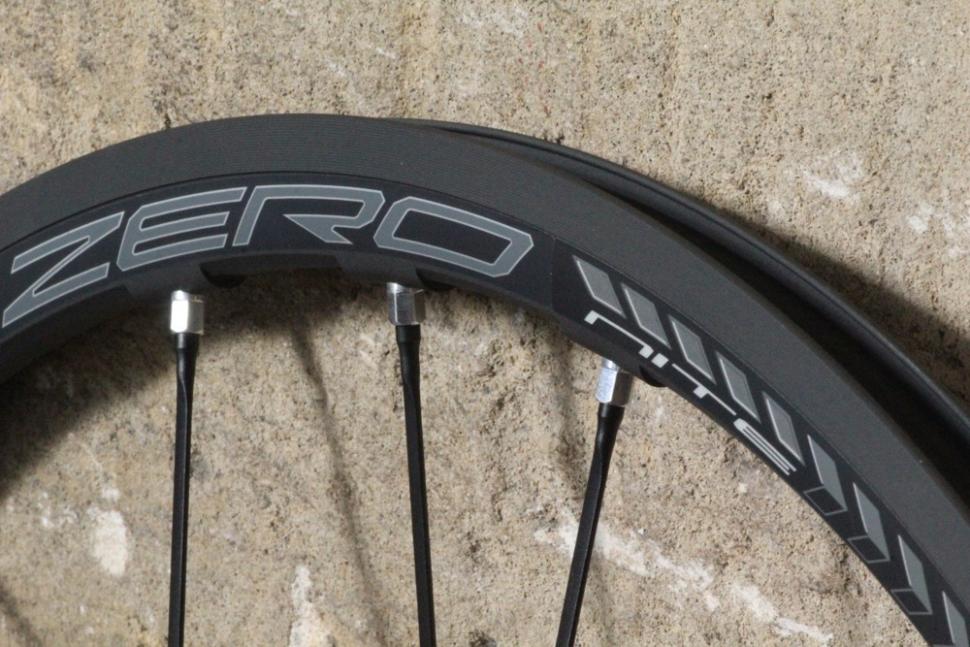



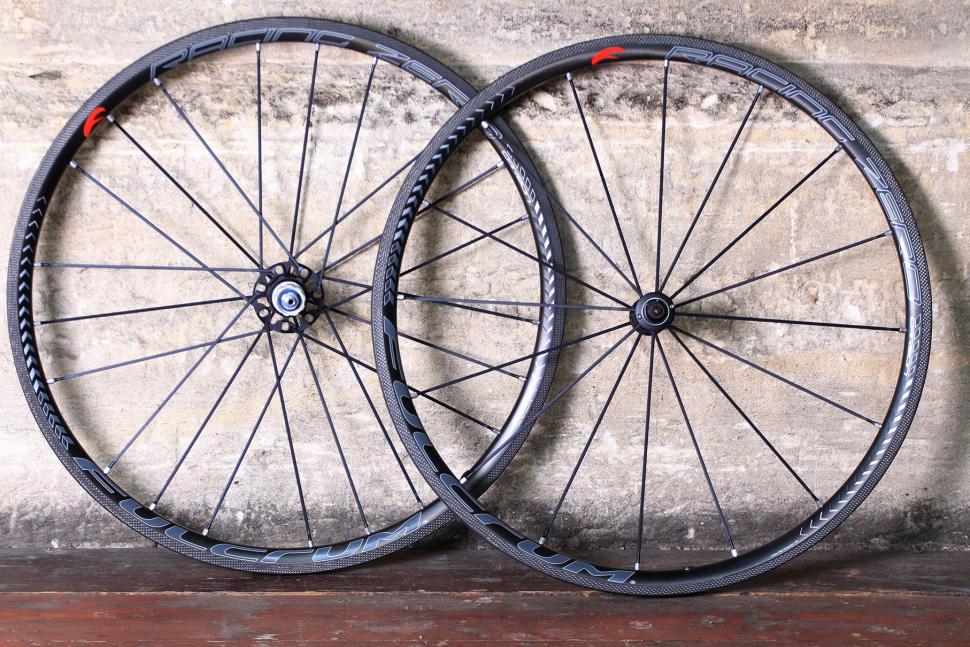








.jpg)
.jpg)


